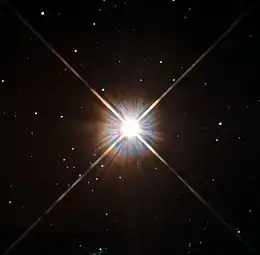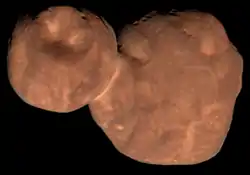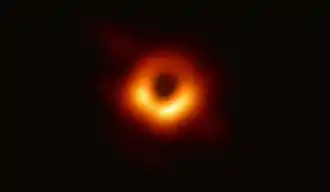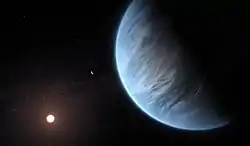Proxima Centauri c
Proxima Centauri c (also called Proxima c[2] or Alpha Centauri Cc) is a very strong exoplanet candidate[note 1] orbiting the red dwarf star Proxima Centauri, which is the closest star to the Sun and part of a triple star system. It is located approximately 4.2 light-years (1.3 parsecs; 4.0×1013 kilometres) from Earth in the constellation of Centaurus, making it and Proxima b the closest known exoplanets to the Solar System.
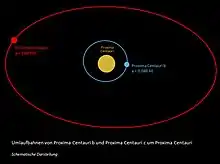 Schematic: Orbits of Proxima Centauri b and Proxima Centauri c around Proxima Centauri | |
| Discovery[1] | |
|---|---|
| Discovered by | Damasso et al. |
| Discovery site | HARPS |
| Discovery date | January 2020 |
| Radial velocity | |
| Orbital characteristics | |
| 1.489±0.049 AU[2] | |
| Eccentricity | 0.04±0.01[3] |
| 1928±20 d[3] | |
| Inclination | 133±1[3] |
| 331±1[3] | |
| −4±4[3] | |
| 2456202±21[3] | |
| Semi-amplitude | 1.1±0.2[3] |
| Star | Proxima Centauri |
| Physical characteristics | |
| Mass | 7±1 M⊕[3] |
| Temperature | 39 K (−234.2 °C; −389.5 °F)[1] |
Proxima Centauri c is a super-Earth or mini-Neptune about 7 times as massive as Earth, orbiting at roughly 1.49 astronomical units (223,000,000 km) every 1,928 days (5.28 yr).[3] Due to its large distance from Proxima Centauri, the exoplanet is unlikely to be habitable, with a low equilibrium temperature of around 39K.[1]
The planet was first reported by Italian astrophysicist Mario Damasso and his colleagues in April 2019. Damasso's team had noticed minor movements of Proxima Centauri in the radial velocity data from the ESO's HARPS instrument, indicating a possible second planet orbiting Proxima Centauri.[5] The discovery was published in January 2020.[1] In June 2020, the planet's existence was confirmed using Hubble astrometry data from c. 1995, allowing its inclination and true mass to be determined.[3][6] Also in June 2020, a possible directly imaged counterpart of Proxima c was detected in the infrared with SPHERE, but the authors admit that they "did not obtain a clear detection". If their candidate source is in fact Proxima Centauri c, it is too bright for a planet of its mass and age, implying that the planet may have a ring system with a radius of around 5 RJ.[7]
Notes
- Although Proxima c has been independently detected by at least two (and likely three) detection methods, it is not explicitly described as a confirmed planet by any peer-reviewed source. It is considered to be confirmed by Fritz Benedict and Barbara E. McArthur in a (non-peer-reviewed) research note,[3] as well as by the Extrasolar Planets Encyclopaedia.[4] Note also that the existence of Proxima c has not been disputed.
References
- Damasso, Mario; et al. (January 2020). "A low-mass planet candidate orbiting Proxima Centauri at a distance of 1.5 AU". Science Advances. 6 (3): eaax7467. Bibcode:2020SciA....6.7467D. doi:10.1126/sciadv.aax7467. Retrieved 23 July 2020.
- Kervella, Pierre; Arenou, Frédéric; Schneider, Jean (March 2020). "Orbital inclination and mass of the exoplanet candidate Proxima c". Astronomy & Astrophysics. 635: L14. arXiv:2003.13106. Bibcode:2020A&A...635L..14K. doi:10.1051/0004-6361/202037551.
- Benedict, G. Fritz; McArthur, Barbara E. (June 2020). "A Moving Target—Revising the Mass of Proxima Centauri c". Research Notes of the AAS. 4 (6): 86. Bibcode:2020RNAAS...4...86B. doi:10.3847/2515-5172/ab9ca9. Retrieved 23 July 2020.
- "Proxima Centauri c". The Extrasolar Planet Encyclopaedia (exoplanet.eu). Retrieved 2020-10-01.
- Billings, Lee (April 12, 2019). "A Second Planet May Orbit Earth's Nearest Neighboring Star". Scientific American. Retrieved April 12, 2019.
- Benedict, Fritz (June 2, 2020). "Texas astronomer uses 25 year-old Hubble data to confirm planet Proxima Centauri c". McDonald Observatory. University of Texas.
- Gratton, R.; et al. (June 2020). "Searching for the near-infrared counterpart of Proxima c using multi-epoch high-contrast SPHERE data at VLT". Astronomy & Astrophysics. 638: A120. arXiv:2004.06685. Bibcode:2020A&A...638A.120G. doi:10.1051/0004-6361/202037594.
